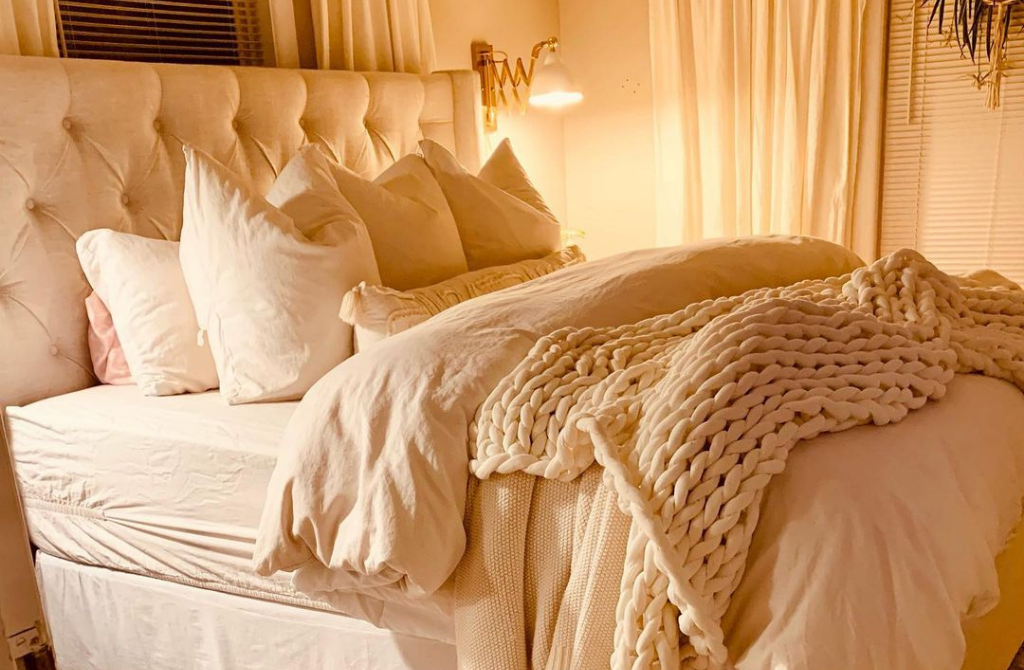You’ll spend 1/3 of your life in bed, so you might as well make it as comfortable as possible. But choosing new bedding can be overwhelming with all the different fibers, weaves, care instructions and thread counts. There are a lot of options, but what’s right for someone else might not be the best choice for you. Read on for a quick primer on all things bedding, so you can upgrade your bed linens with confidence.
Thread Count
The thread count of a sheet set refers to the number of horizontal and vertical threads per square inch. It used to be true that the higher the thread count, the softer the fabric, but that isn’t necessarily true these days. Advances in technology and machine finishes means you can get a very soft set of sheets with a thread count of 200, and manufacturers can also inflate thread count numbers with technicalities (i.e. if the yarn used is twisted). Generally speaking, sheets with a thread count of 300-400 will be soft and durable. For extra softness, look for combed or satin finishes.

Fabrics
The fiber content of bedding refers to the fabrics that have been used to make it. The fibers that fabrics are made from fall into two categories, natural and synthetic. Natural fibers are generally derived from plants (with the exception of silk), and synthetic fibers are manmade. There are pros and cons to both types of fibers, and very often in bed linens, a blend of multiple fiber types is used. Make sure you’re noting the fiber content before you make a purchase, so you are aware of the care instructions and also, after reading the below, so you know what properties each fabric possesses.
Cotton
Cotton is the most common fabric for bedding. It’s a natural fiber, made from the cotton plant. Cotton bedding is easy to care for and breathable, but may wrinkle and take a few washes to get to peak softness. Cotton bedding is available in a number of different weaves and types:
- Egyptian cotton well known for being high quality as it has extra long fibers, making it very soft.
- Organic cotton means that the plants were grown without any pesticides, making it a great choice for anyone with sensitive skin.
- Pima cotton has a medium-length fiber, which are soft with a natural sheen. Supima is a trademarked name for fabrics made from 100% American Pima cotton.
- If 100% cotton sheets aren’t labeled as one of the above types, they're most likely made from upland cotton, which has a shorter fiber, making them more affordable.
Bamboo
Bamboo fabric, as you probably guessed, is made with fiber from the bamboo plant. Since bamboo grows super fast, it’s a great sustainable option. Bamboo bedding is generally lightweight, durable, and has cooling properties, but can wrinkle and requires gentle cleaning.
Flannel
If you live in a cooler climate, you’re probably familiar with flannel sheets. They’re generally made from cotton, wool, or synthetic fibers, and are combed in the finishing process for extra softness and warmth. Because they’re warmer, they trap body heat in, making them not an ideal choice for hot sleepers, but they are easy to care for and don’t wrinkle. Flannel sheets are measured in weight with GSM (grams per square meter) instead of thread count. Look for a GSM of 170 or higher for a durable set of sheets.
Jersey
If you’ve ever felt jersey sheets, you’ll know they feel very similar to your favorite t-shirt. Jersey is a type of knit fabric (instead of woven) that is usually made from cotton. Jersey bedding is super soft, but as it’s knit, can stretch out more quickly than woven sheets. It doesn’t have the same coolness that woven bedding does, but is very cozy.
Microfiber
Microfiber is made from tightly woven synthetic fabrics, usually polyester or nylon. Microfiber sheets are very soft and affordable, but can attract pet hair and static, and have a tendency to pill over time.
Silk
Silk is a luxurious, smooth fiber produced by silkworms. Aside from being cooling and great for warm climates, silk sheets are also hypoallergenic. They also have great benefits for your hair and skin, but tend to be costly and require careful care.
Blends

As previously mentioned, bedding can be made up of multiple types of fibers blended together. They can be wide ranging in price and benefits. As textile technologies continue to evolve, we’ll continue to see more innovation in bed linens. For instance, these high performance cotton sheets are blended with Celliant, a trademarked technology that converts your body heat into infrared energy, improving sleep and recovery.

